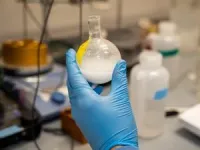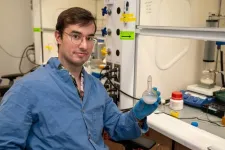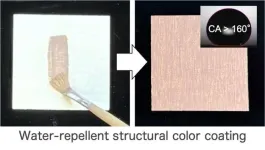(Press-News.org) As we burn fossil fuels, the amount of carbon dioxide in Earth’s atmosphere is gradually rising, and with it, the planet’s average temperature. How fast the level of atmospheric carbon dioxide — and with it, the temperature — goes up matters for the ability of humans and ecosystems to adjust. A slower increase gives humans time to move away from low-lying coasts and animals time to move to new habitats.
It turns out the rate of that increase matters for non-living systems, too. A recent University of Washington study looked at how a major current in the Atlantic Ocean that includes the Gulf Stream will respond to a doubling of carbon dioxide from preindustrial levels. The study, published in the Proceedings of the National Academy of Sciences, found that when carbon dioxide levels rise more gradually, they have less impact on the ocean circulation.
Camille Hankel, a UW postdoctoral researcher in the Cooperative Institute for Climate, Ocean and Ecosystem Studies, answered questions about her research.
Why did you choose to study how the rate of rising CO2 affects the climate system?
Camille Hankel: In my PhD, some of my work was on “climate tipping points,” which emerge from the hypothesis that there might be some sort of critical thresholds of warming or CO2 change that can lead to very abrupt and irreversible change in some parts of the climate system. Through that work, I got exposed to some literature on “rate-induced tipping points,” which is the idea that instead of crossing a critical level, that there could be some critical rates of CO2 change that are important for the climate system.
Specifically, I read this study that was looking at this idea in the context of the AMOC, the Atlantic Meridional Overturning Circulation, which is this large-scale ocean circulation. That study was using what we call a box model — a simplified, mathematical representation of the ocean circulation. And I thought, hey, I can run these global models, which are much more realistic representations of the Earth’s climate, including ocean, atmosphere, land, and sea ice, and test whether the rate of CO2 change really is that important.
What is the Atlantic Meridional Overturning Circulation, which includes the Gulf Stream ocean current, and why is it so important for Earth’s climate?
CH: It’s one of the large-scale, key features of the climate system. In particular, it transports a lot of heat from the low latitudes in the South Atlantic to the higher latitudes closer to the North Pole. So it delivers a lot of heat, primarily to Northern Europe. It also distributes nutrients around through this sort of sinking motion that characterizes the circulation — it draws the surface waters down into the deep ocean, and recirculates deep water up to the surface. It’s a big feature of the climate system, particularly in the North Atlantic, but also globally.
We’ve heard about a potential slowdown of the Gulf Stream current that could affect European weather. This was dramatized (perhaps not accurately) in the 2004 disaster movie ‘The Day After Tomorrow.’ Are we actually seeing a slowdown in Atlantic Ocean circulation?
CH: We have a pretty short observational record of the AMOC current, and it's sparse. You have to imagine, this is a 3D circulation in the entire Atlantic basin, and we have a couple little slices of data in particular parts of the Atlantic. We are seeing a modest slowdown so far, but it's a pretty noisy and uncertain observational record, so it's hard to tell.
I would say, however, that slowdown seen in current observations would match the model predictions of future slowdowns. And we also see a pattern in temperature changes where, while the rest of the globe is warming right now as we increase CO2, there's what people call a “warming hole” over the North Atlantic: We’re not seeing as much warming in that North Atlantic region compared to the rest of the globe. And it's hard to conclusively attribute what's causing it in the Earth's climate, but the idea is that the modest slowdown of the AMOC that we've seen so far could be one contributing factor to that lack of warming we're seeing in the North Atlantic.
So the observations suggest some slowdown, though much less dramatic than what was depicted in that movie.
Why is the AMOC expected to slow down under climate change?
CH: One way of thinking about what drives this major ocean current is differences in ocean density. You have this really important zone in the North Atlantic where the waters sink because the surface waters are heavier than the waters below. When you change CO2 levels, you do two things. You start to warm the ocean’s surface, and by melting glaciers as well as changing sea ice, you add freshwater to the surface of the otherwise salty ocean. Both warming and freshening reduce the density of that upper ocean water and potentially inhibit or disrupt that critical sinking motion.
There are other ways of looking at it, but the one I look at in the study is understanding how those density perturbations happen in a higher-CO2 climate and how they modulate the sensitivity to the rate of CO2 change that I find in the AMOC’s response to CO2.
Your study finds that if atmospheric carbon dioxide doubles from pre-industrial levels more slowly, there’s less slowdown in the Atlantic Ocean compared to if CO2 doubles more quickly. Is that because everything is happening more slowly?
CH: Yes, that’s part of it. The different parts of the climate system — the ocean, atmosphere, and ice — all have different response timescales to CO2 changes, meaning they respond to perturbations with different lag times. Then how these components of the climate interact with each other under slower or faster CO2 changes can look very different, and in this case influence the ocean circulation.
Specifically, I found what’s known as a positive feedback — a sort of self-amplifying cycle — that helps explain why the level of AMOC weakening depends on the rate of CO2 change. In this feedback cycle, the initial modest amount of AMOC slowdown leads to a reduction of heat transport into the Arctic, which in turn cools the region and leads to a temporary period of Arctic sea ice expansion. This sea ice expansion causes more ice to be exported to the North Atlantic, where it melts and adds freshwater to the ocean, causing the AMOC to slow down even more: hence the self-amplifying cycle. It turns out that this feedback cycle is more effective at amplifying AMOC weakening under more rapid CO2 changes than under gradual CO2 changes.
What is the importance of this work?
CH: We know about AMOC slowdowns — there's a ton of work on that, and the mechanisms that drive such an AMOC slowdown. But what’s new is this sensitivity of the circulation changes to the rate of CO2 increase, independent of the total change in concentration of CO2.
When we think about policy and basic science, we tend to focus a lot on how the level of global warming can impact the climate system. I'm trying to bring a new perspective by thinking about the rate of increase as a driver itself, that could have a lot of impacts.
You can imagine that if multiple different climates are possible for the same level of warming, then limiting us to 1.5 C or 2 C could have different meanings, right? I do think the most important thing for the climate system is always how much CO2 have you put into the atmosphere, but how quickly you got to that point clearly matters as well.
For more information, contact Hankel at crhankel@uw.edu.
END
Q&A: How rate of CO2 rise can affect a global ocean current
2025-01-28
ELSE PRESS RELEASES FROM THIS DATE:
The oral microbiome and dementia
2025-01-28
The microbial ecosystems within our mouths may affect our cognitive function as we age, according to a study. Interventions such as prebiotics, including dietary nitrate, have potential for delaying cognitive decline.
About 15% of older adults have mild cognitive impairment, which is the largest risk factor for the development of dementia or Alzheimer’s disease. There is a known association between periodontitis—gum disease—and worsened cognitive function. Researchers have identified two possible links between the mouth and the mind: pathogenic ...
Paywalls shape newspaper coverage
2025-01-28
Adopting paywalls subtly shapes newspaper coverage, according to a study. Online journalism is increasingly found behind paywalls, as outlets pivot from funding their operations by selling ads to relying on subscriptions for revenue. This shift has raised questions about how newspapers might adjust their coverage to cater to paid subscribers' desires for popular news and soft news—entertainment, lifestyle, sports, and human-interest stories—at the expense of providing local news and maintaining democratic accountability. Paramveer S. Dhillon ...
Escaping the endosome: Bend lipids improve LNP mRNA delivery and gene editing
2025-01-28
Every time a shuttle docks with the International Space Station (ISS), a delicate dance unfolds between the shuttle's docking system and its counterpart on the station. Thanks to international standards, these mechanisms are universally compatible, ensuring astronauts and cargo can safely and seamlessly enter the station.
A similar challenge arises at the microscopic level when lipid nanoparticles (LNPs) — the revolutionary drug delivery vehicles behind the COVID-19 vaccines — attempt to deliver mRNA to cells. Optimizing the design and delivery of LNPs can greatly enhance their ability to deliver mRNA successfully, ...
Could fecal microbiota transplantation help patients heal after stem cell transplantation?
2025-01-28
SEATTLE — Jan. 28, 2025 — A new study shows that oral fecal microbiota transplantation (FMT) is a feasible and safe addition to preventing graft-versus-host disease in patients undergoing stem cell transplantation for blood cancers.
The study, published Jan. 25 in Nature Communications, is part of a phase 2 clinical trial led by clinicians at Fred Hutch Cancer Center. The study builds on earlier research of the role of the gut microbiome in helping patients recover after stem cell transplantation.
“The gut microbiome is an organ in itself, and it is connected to the immune system,” said lead author Armin ...
Structural color shields: water repellent coatings
2025-01-28
Ever wondered about the brilliant blue hues of peacock feathers or the shimmering metallic chitin on beetles? These natural wonders are examples of structural colors—a phenomenon in which microscopic structures create vibrant, lasting hues. Inspired by these marvels, a research team from Japan has been exploring structural colors. Their earlier work realized that the preparation of structural color materials from melanin particles mimics the coloration mechanism of peacock feathers. Building on this foundation, the team set out to develop a coating material that captures ...
Researchers enhance wildlife studies with novel prey measurement technique using animal-borne cameras
2025-01-28
A team of international scientists, led by researchers from the University of Otago, has introduced a groundbreaking method to improve the accuracy of prey size estimation using footage captured by animal-borne cameras. This innovative approach, published in PeerJ Life and Environment, enhances our understanding of predator-prey interactions in natural habitats by refining a critical tool for ecological research.
Animal-borne cameras, such as the "PenguCams" used in this study, allow ...
An injectable hydrogel for local bone densification
2025-01-28
Osteoporosis is a disease in which bone resorbs faster than it is formed, gradually weakening its structure over time and leading to fractures. Although the condition is well recognized, Dominique Pioletti, head of the Laboratory of Biomechanical Orthopedics in EPFL’s School of Engineering, emphasizes that the economic and societal impacts of osteoporosis fractures are often underestimated.
“In the absence of effective preventive measures, around 40% of women aged 50 will suffer at least one major osteoporotic fracture; in ...
Forgery and fiscal fraud: a new papyrus from Israel reveals a spectacular criminal case from the Roman empire
2025-01-28
Scholars from the Austrian Academy of Sciences, the University of Vienna and the Hebrew University of Jerusalem unveil a unique papyrus from the collections held by the Israel Antiquities Authority, offering rare insights into Roman legal proceedings and life in the Roman Near East. In a new publication in the international scholarly journal Tyche, the research team reveals how the Roman imperial state dealt with financial crimes – specifically, tax fraud involving slaves – in the Roman provinces of Iudaea and Arabia. The new papyrus furnishes a strikingly direct view of Roman jurisdiction and legal practice, as well as important new information ...
A super-Earth laboratory for searching life elsewhere in the Universe
2025-01-28
Thirty years after the discovery of the first exoplanet, we detected more than 7000 of them in our Galaxy. But there are still billions
more to be discovered! At the same time, exoplanetologists have begun to take an interest in their characteristics, with the aim of finding life elsewhere in the Universe. This is the background to the discovery of super-Earth HD 20794 d by an international team including the University of Geneva (UNIGE) and the NCCR PlanetS. The new planet lies in an eccentric orbit, so that it oscillates in and out of its ...
Testing the effect of thousands of compounds on cellular metabolism
2025-01-28
Researchers at the University of Basel are able to test in parallel the effects of over 1500 active substances on cell metabolism. Their analysis also led to the discovery of previously unknown mechanisms for known medications. This approach might help scientists to better predict side effects and find additional uses for commercially available pharmaceuticals.
How do active substances alter metabolic processes in cells? Answering that question would provide valuable clues for the development of new medications. ...








